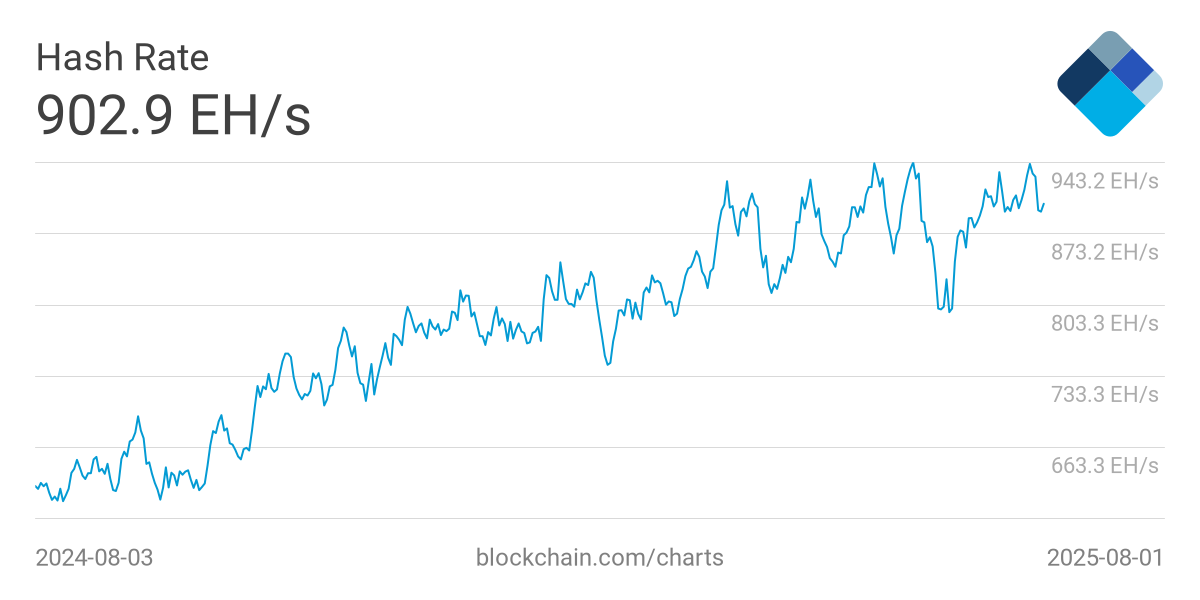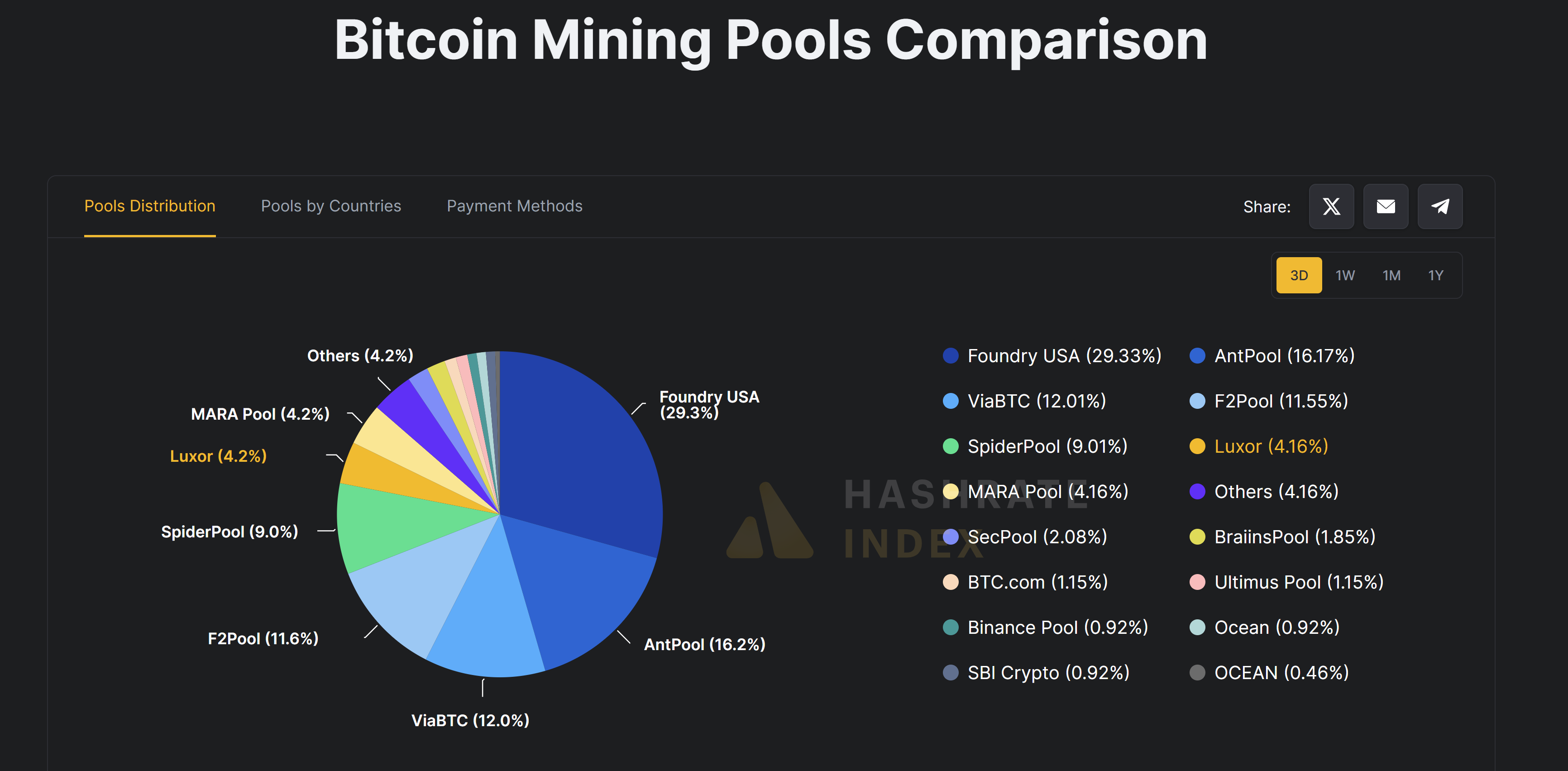Solo miners have been defying the chances, efficiently claiming full Bitcoin block rewards even because the community hashrate hovers close to all-time highs.
As of this writing, the Bitcoin (BTC) community’s hashrate is hovering round 902 exahashes per second (EH/s), slightly below its all-time peak, in keeping with Blockchain.com. The determine exhibits rising competitors and better issue, suggesting that single miners face steep odds to win a block.
Nevertheless, final week, a solo miner defied these odds, securing block 907,283 by way of the Solo CK pool and incomes the complete 3.125 BTC reward, value over $372,000 on the time. The miner additionally acquired a further $3,436 in transaction charges.
That win wasn’t an remoted occasion. Earlier in July, one other miner with simply 2.3 petahashes of energy claimed a full block reward, whereas comparable wins had been recorded in June, March and again in February.
“We’re seeing solo miners win blocks not due to luck, however as a result of they’re operating highly effective, environment friendly {hardware},” Samuel Li, chief expertise officer of ASICKey, instructed Cointelegraph. He added that fashionable miners are constructed to ship “critical hashrate” with out the large energy draw of conventional setups.

Bitcoin community hashrate. Supply: Blockchain.com
Associated: Solo Bitcoin miner scores $373,000 block reward
Effectivity in focus
For solo miners, effectivity is the whole lot, Li stated. “Take our KEYMINER A1—it attracts simply 650 watts however delivers 1,100 TH/s on Bitcoin, with month-to-month earnings round $1,200. For these diversifying into altcoins, it might probably earn as much as $3,800 monthly mining Sprint,” he famous.
The KEYMINER A1 is a part of ASICKey’s {hardware} line launched final November, which additionally contains the KEYMINER X and KEYMINER PRO.
In keeping with the corporate, the KEYMINER X delivers 2,300 terahash per second (TH/s) at 1,300 watts, whereas the PRO mannequin affords as much as 5,800 TH/s at 2,800 watts. Below present market circumstances, the corporate estimates month-to-month returns of as much as $6,300 for the PRO.
Nevertheless, regardless of the enhancements in application-specific built-in circuit (ASIC) effectivity, the “elementary odds [of solo miners winning] haven’t shifted a lot,” Li stated.
“Solo mining remains to be principally a lottery, until you management tens of PH/s, which is realistically the naked minimal for having a measurable statistical shot at success inside an inexpensive timeframe,” he added.
Li defined that at immediately’s Bitcoin community hashrate, a miner with one petahash (PH/s) of hashpower has a couple of 1 in 650,000 likelihood of fixing a block each 10 minutes. One peta hash (PH/s) is equal to 1,000 terra hashes (TH/s).
Associated: Tether plans to open-source Bitcoin mining OS; CEO says ‘no want’ for third social gathering distributors
Why are miners going solo?
Li confirmed that there was a “modest resurgence” of curiosity in solo mining, however for various causes. “Some miners are selecting it not for predictable revenue, however for the potential of a giant reward—6.25 BTC plus charges—which will be transformative if gained,” he famous.
Whereas financial incentives play a key position, some are pushed by ideological motives, valuing community decentralization and the flexibility to function independently of centralized mining swimming pools.
In keeping with knowledge from Hashrate Index, US-based mining pool Foundry USA continues to dominate Bitcoin mining, commanding 29.3% of the entire hashrate. AntPool follows with 16.2%, whereas ViaBTC and F2Pool maintain 12.0% and 11.6% respectively.

Bitcoin mining swimming pools. Supply: Hashrate Index
If a single pool (or a number of swimming pools appearing collectively) management greater than 50% of the hashrate, they may theoretically launch a 51% assault, which might permit them to double-spend cash. Whereas uncommon and dear, such an occasion would erode belief within the community.
“Finally, extra solo miners—particularly these working on clear vitality and environment friendly {hardware}—might signify a more healthy, extra decentralized Bitcoin community, which is aligned with the unique imaginative and prescient of permissionless participation,” Li concluded.
Journal: AI might already use extra energy than Bitcoin — and it threatens Bitcoin mining









